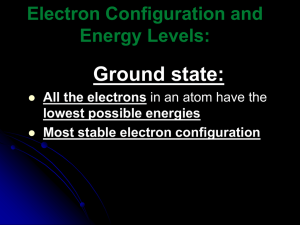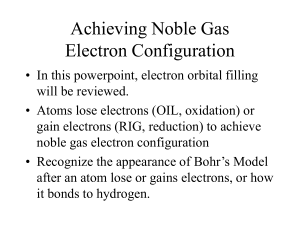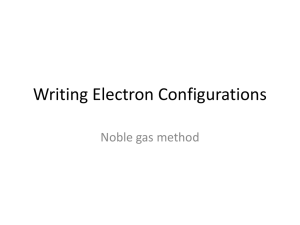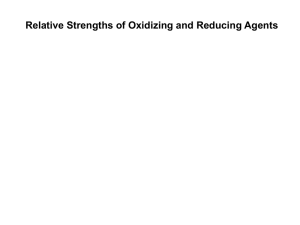Check-in
advertisement
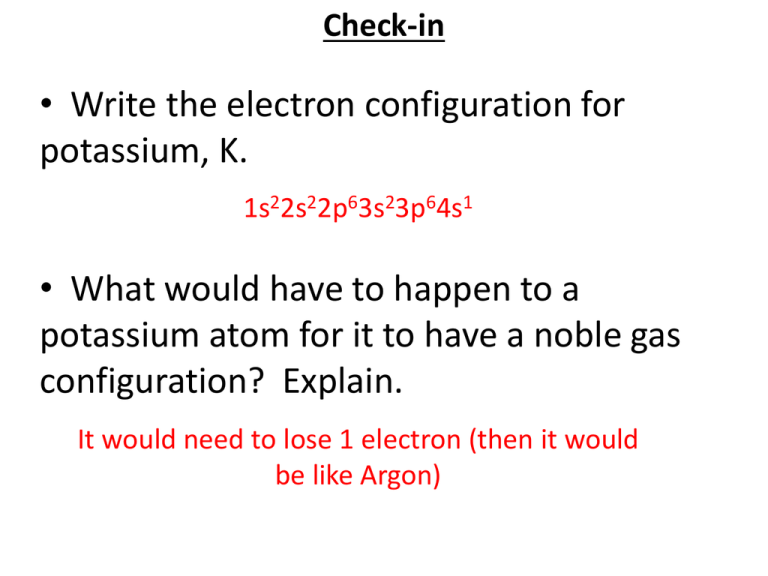
Check-in • Write the electron configuration for potassium, K. 1s22s22p63s23p64s1 • What would have to happen to a potassium atom for it to have a noble gas configuration? Explain. It would need to lose 1 electron (then it would be like Argon) Check-in a) What is the charge on the Sn atom after 4 electrons have been removed? +4 b) Does Sn have a noble gas electron configuration once the 4 electrons have been removed? It doesn’t have the same # of electrons as a noble gas, but it still has 18 valence electrons! HOMEWORK 1. Which noble gas is closest to calcium, Ca, on the PT? What must happen to a calcium atom in order for it to have a noble gas electron configuration? Argon, it must lose 2 electrons. HOMEWORK 2. When chlorine gains an electron to become a chloride ion with a -1 charge, it ends up with the noble gas electron configuration of argon. Why doesn’t it become an argon atom? It still has 17 protons & the # of protons determines the type of element. HOMEWORK 3. Explain why the elements on the right hand side of the periodic table receive electrons instead of giving them up. It is easier for these elements to gain electrons because they are closer to the noble gases on the right side of the PT. Card Activity! QUESTIONS TO ANSWER 1. List 3 patterns you notice 2. What happens to the charge on an atom when you remove electrons? Explain, mentioning protons. 3. What happens to the charge when you add electrons? Explain, mentioning protons. Investigation 2.2.2 Activity! 1.Complete the table on page 19. 2.Answer Questions 1 & 2. 3.Answer questions a-j on page 21! Check your work! Element 1 (metal) Na Mg Mg Be Mg Ca # of valence electron s 1 2 2 2 2 2 # of Electrons lost/ ion symbol 1 / Na+ 2 / Mg2+ 2 / Mg2+ 2 / Be2+ 2 / Mg2+ 2 / Ca2+ Element 2 (nonmet al) F O Cl F O Cl # of valen ce electr ons 7 6 7 7 6 7 # of electrons gained/ ion charge 1 / F- 2 / O21 / Cl1 / F- 2 / S21 / Cl- Neutral compound NaF Sodium fluoride MgO Magnesium oxide MgCl2 Magnesium chloride BeF2 Beryllium fluoride MgS Magnesium sulfide CaCl2 Calcium chloride Check your work! Na 1 1 / Na+ Br 7 1 / Br- NaBr K 1 1 / K+ Se 6 2 / Se2- K2Se Al 3 3 / Al3+ N 5 3 / N3- AlN Al 3 3 / Al3+ O 6 2 / O2- Al2O3 Aluminum oxide Al 3 3 / Al3+ F 7 1 / F- AlF3 CHECK-IN: Which elements will combine with Sr, strontium, in a one-to-one ratio? Strontium loses 2 electrons and forms a +2 charge so any of the Group 6A elements (which gain 2 electrons to form a -2 charge) will combine with Strontium 1:1 Would you expect the following pairs of atoms to combine chemically to give an ionic compound? If yes, write the formula for the compound. a. Li & S Li+, S2b. O & S O2-, S2- c. Al & O Al3+, O2d. F & Cl F-, Cl- Li2S N/A Al2O3 N/A Would you expect the following pairs of atoms to combine chemically to give an ionic compound? If yes, write the formula for the compound. e. I & K I-, K+ f. H & N H1-, N3- g. Mg & F Mg2+, F- h. Mg & Na Mg2+, Na+ KI N/A MgF2 N/A Would you expect the following pairs of atoms to combine chemically to give an ionic compound? If yes, write the formula for the compound. i. N & Al N3-, Al3+ j. Ca & Br Ca2+, Br- AlN CaBr2




